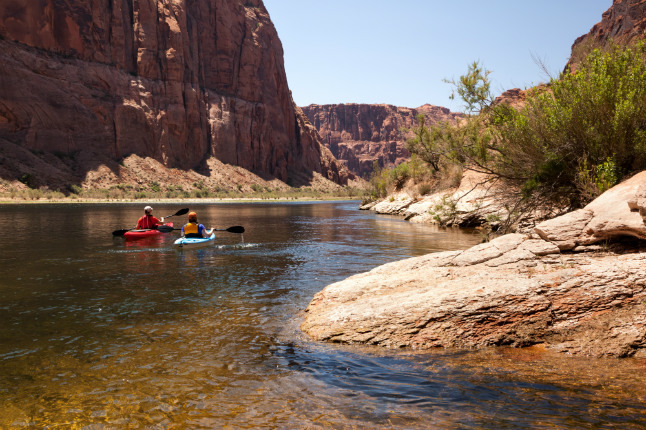ALIVE! Glen Canyon Revived By Drought
We may receive a commission on purchases made from links.
Five years ago this August, I traveled to the shores of Lake Powell to meet journalists from the Salt Lake Tribune. We were there to boat into Clear Creek and see Cathedral in the Desert, the iconic sandstone cavern in Glen Canyon that was inundated by the reservoir's rising waters in the 1960s.
At the time, the Cathedral was still half-full, revealing only a part of what many consider one of the most magical places on the Colorado Plateau.
When our group arrived at Bullfrog Marina, we were greeted by a park ranger. Rich Ingebretsen, founder of the Glen Canyon Institute, explained that some of us were with an organization working to restore the Colorado River. The ranger replied, "Trying to restore the river, huh? Well, I guess we are having a bit of an identity crisis here."
He had certainly seen the reservoir drop, leaving dramatic bathtub rings on the canyon walls. Since Lake Powell was last full in 1999, the reservoir had experienced extreme fluctuations, reaching its lowest point in April 2005. In only six years, it had gone from 99 percent capacity to a mere 30 percent.
Downstream at Lake Mead, things aren't much better. In November 2010, that reservoir reached its lowest point since it began filling in the 1930s. Now, it is becoming clear that more than the reservoirs are facing an identity crisis; so is the Colorado River—and the more than 30 million people who rely on it today.
Water management in the arid Southwest may be at a breaking point. If you've tuned into the news lately, you've heard the dire stories of drought in the Colorado River Basin. There also have been numerous studies from government agencies and academic institutions assessing the imbalance on the Colorado River between supply and demand. One study from the U.S. Forest Service and Princeton University concluded that both Powell and Mead could dry up in a few decades.
Increasing demand, persistent drought and climate change are all tightening their grip on the water supply of the West—even as Las Vegas works to complete its "third straw," an intake valve pulling water from Lake Mead. That valve, however, could end up installed in a near-empty reservoir. And for the first time in history, Glen Canyon dam managers have announced that they will begin to curtail downstream releases to mitigate shortages.
Pat Mulroy, the powerful director of the Southern Nevada Water Authority, recently said, "It is the new normal. And it is climate change. We are living what the scientists (have said) for the last couple of years, that the rate of change that we are experiencing climatically is far more dramatic than they expected it to be."
Meanwhile, as the reality of this "new normal" becomes more palpable every year, a miraculous transformation has been taking place in once-drowned Glen Canyon.
As the waters of Lake Powell retreat, the area once called "the place no one knew" is coming back to life. When Lake Powell reached its previous lowest point in the spring of 2005, there was a surge of interest in the newly emerged canyons of Glen Canyon. Outdoor enthusiasts, news media and photographers flocked to walk on the floor of Cathedral in the Desert. A headline in The New York Times proclaimed, "Glen Canyon is on its way back—viewable in much of its former glory."
Between 2003 and 2007, journalist Annette McGivney and photographer James Kay rediscovered the recovering side canyons of Glen Canyon. In creating their book Resurrection: Glen Canyon and a New Vision for the American West, the two hiked up 40 side canyons to document the re-emergence of what had once been proposed as a national park. It had been widely assumed that all the 160 inundated side canyons of Glen Canyon were lost to Lake Powell, but McGivney and Kay were amazed to witness the rebirth of large portions of this magical place.
Places like Smith Fork, Willow Gulch and Davis Gulch, once smothered by 30 feet of sediment, had been flushed out by flash floods and largely returned to their natural state. The waterfalls, slot canyons, plants and wildlife had reappeared in a few short years. According to James Kay, "It was nothing short of a miracle."
Over the next couple of years, if current conditions continue, we might be able to see more of these miracles. With both the Powell and Mead reservoirs hovering around half-full, and with little possibility that they will ever be filled again, it is time to rethink the way we store Colorado River water.
A recent study in the Journal of the American Water Resources Association, said that by prioritizing water storage in Lake Mead, we could save the same amount of water that's now lost to seepage from Lake Powell—an amount equivalent to the entire state of Nevada's annual Colorado River allocation.
Based on these data and the immeasurable value of a restored Glen Canyon, it just makes sense to allow Lake Mead to fill first. Then the world beneath Lake Powell could once again spring back into life.
–
This article first appeared in High Country News.
